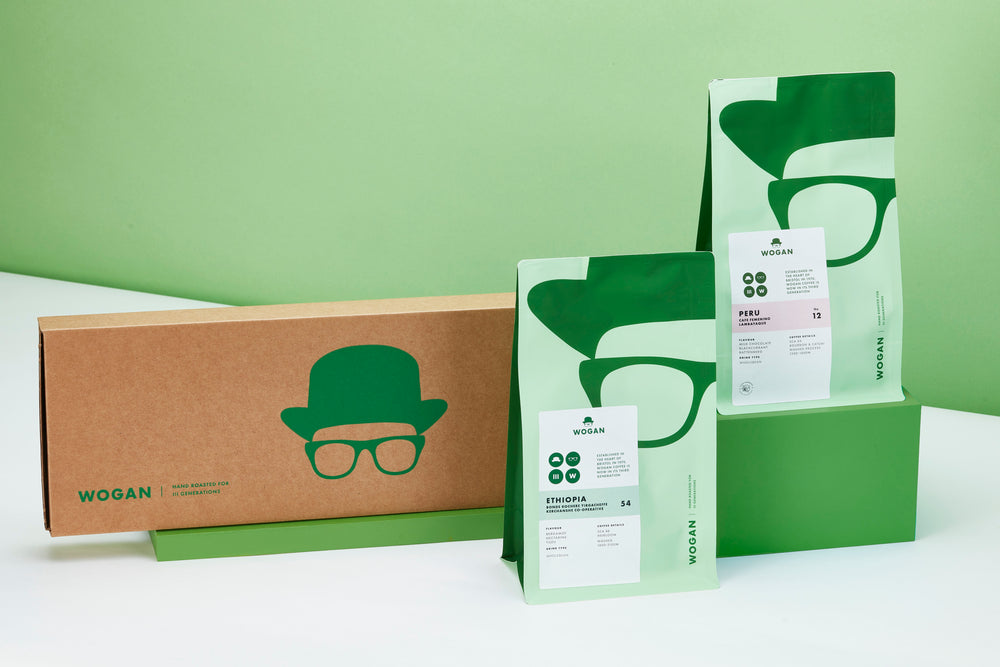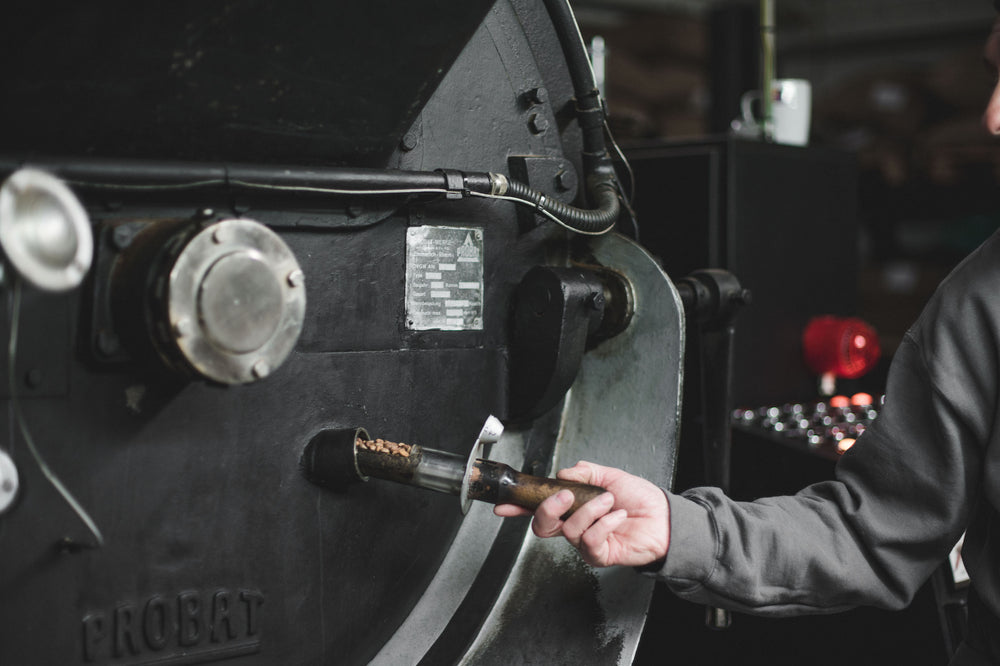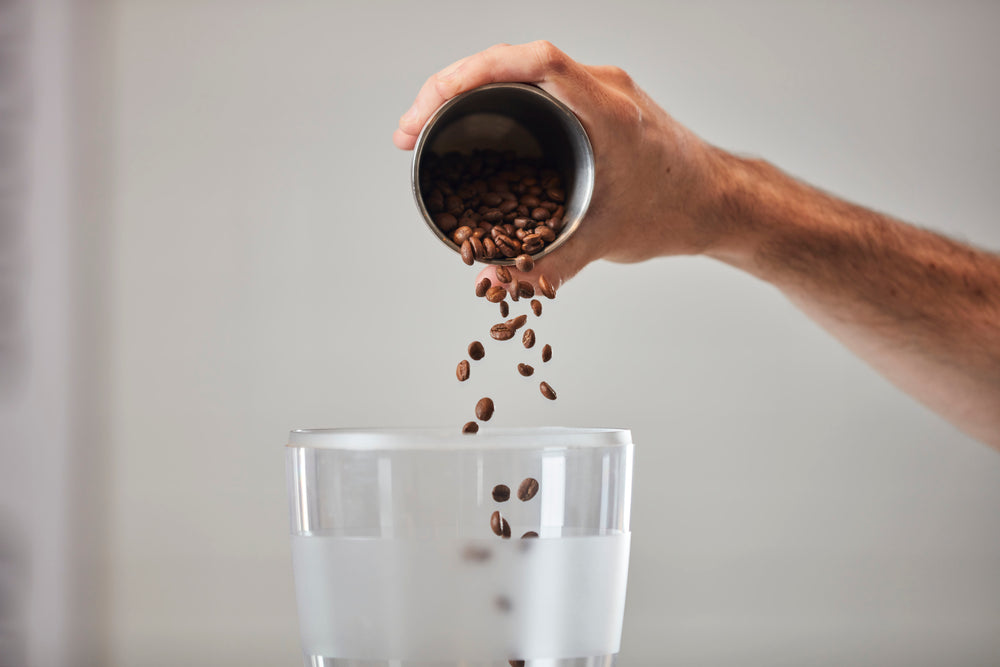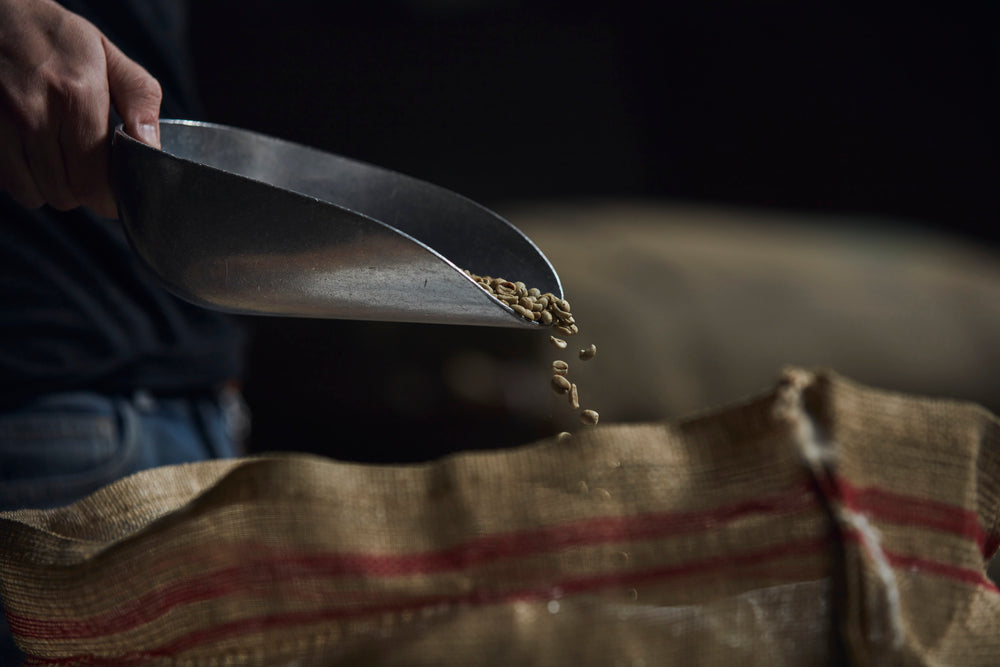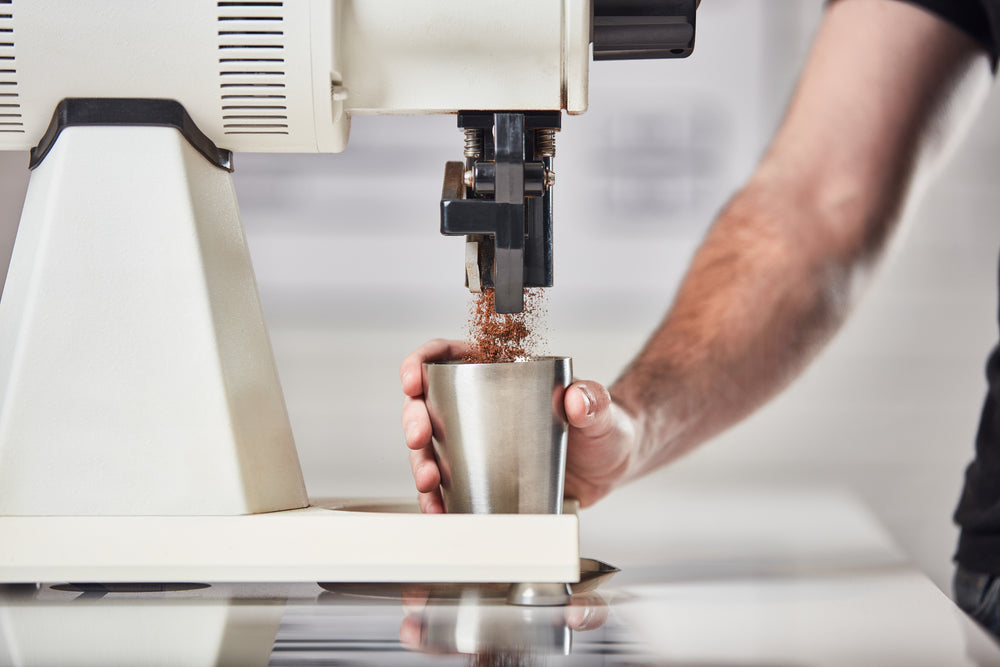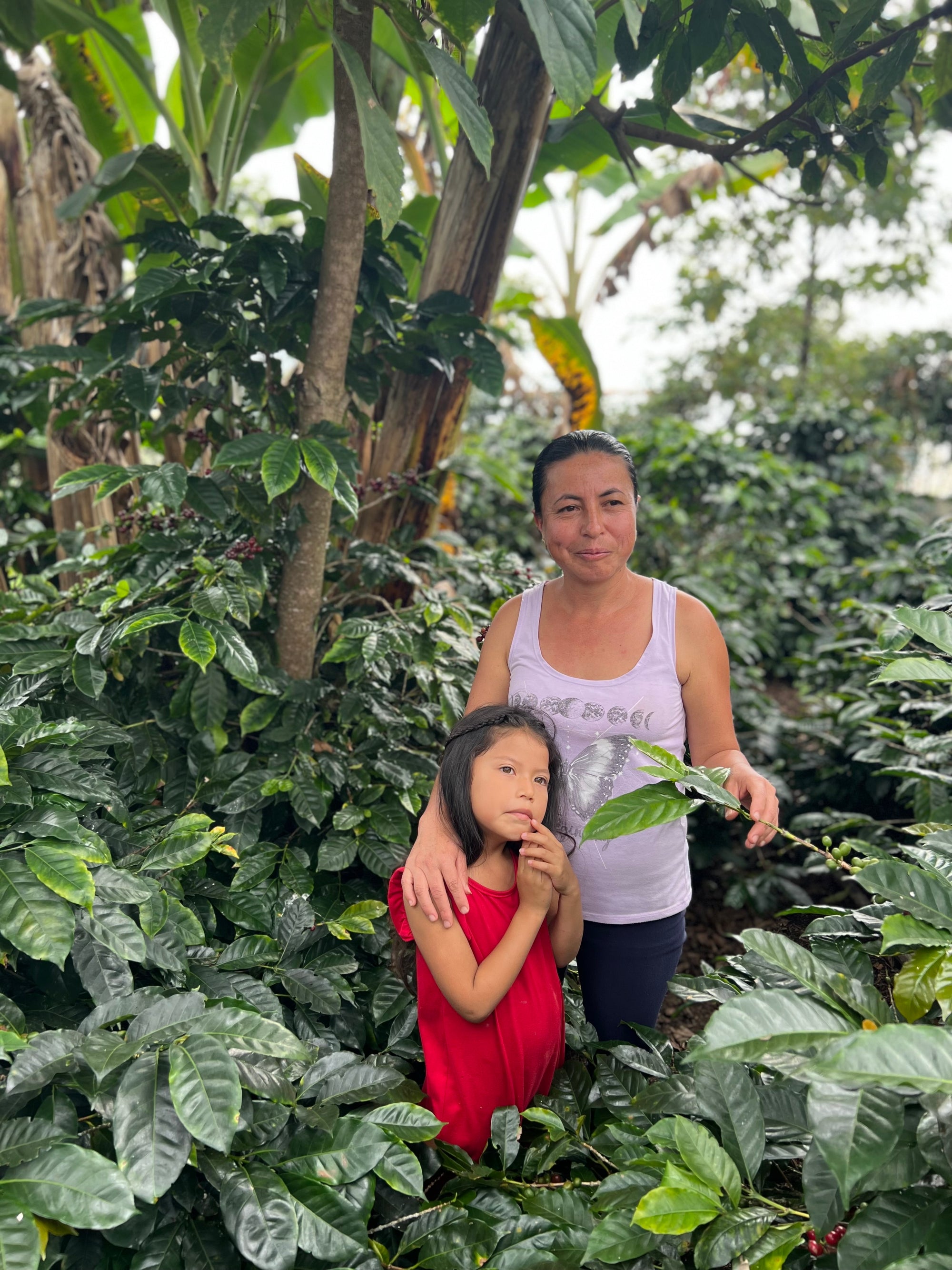One of the many wonderful perks of working in coffee, is the opportunity to go to source and visit both the farms that we import our coffee from, but also others in the surrounding area. The grand finale of this trip was visiting one of our most popular coffees, Colombia La Laguna. It was an incredible experience to be able to meet the farmers who produce our coffee, and to see first-hand the loving care that they put in to its harvesting and processing.
Day 1 - El Peñol
After a very traditional breakfast of arrepas with eggs and raw cheese, we visited the first farm. Castillo variety, and Castillo only, the beans undergo fermentation for two days due to cold climate and altitude (2000m). ‘Magic water’ - the water from the pulper - is used in the nursery and sprayed into plants. Cherries etc are used as fertiliser. Raised beds under tarp are used for drying. Beautiful farm, lovely dog.
The buying station- Sonia, El Peñol, purchases everything by volume, due to the massive differences in humidity - some people deliver dried for a day, some deliver ‘wet’, depending on the weather at the time. It has to be this way because there’s so many smallholder farms, and coffee usually isn’t even the main crop for each farmer, so the intermediary groups it all together. Coffee is sent in parchment, and then measured by the ‘pucha’. This happens Thursday through Sunday (mainly Sunday), and farmers are paid on the spot - they buy all their fruit and vegetables at the same market. A lot of beans that don't make it past the grading proces are still kept and sold locally. The coffee is then sent to dry (outside or mechanical weather depending) and then to be milled.
Lunch! Beautiful place overlooking Guatapé rock… had ‘tree tomato’ juice, no idea what that is but somehow tastes like orange and tomato mixed together. Then had Bandejas - beans in a sauce, with rice, dried plantain, a fried egg and ‘chorizo’.
The second farm, Don Julio (or Juan); overlooking Guatapé (actually a lake created by dams for hydroelectric power, now a tourist centre). Watched farmers process the beans that we ate for lunch, then walked - owner of the farm is 88 but still works every day with his family. He actually grew up about 100m from the farm. Used to be all typica, now they’ve planted lots of Castillo for rust-proofing etc. Beautiful.
Dinner! Drove all the way to Bolivar, which is just over three hours. Drove through Medellin, the start of which was stunning - so much greenery, genuinely felt like someone just plonked a city in the middle of the rainforest. Also drove through an 8km tunnel… got to the other end of the trip, went to stop at a restaurant in a tiny village, and the owners actually turned us away because it was getting late and pitch black, and they warned us that it would be too dangerous to stay there! Becoming more convinced that one of the guys with us, who’s very quiet, is here for security, because we moved seriously quickly and drove incredibly fast! Drove past the most stereotypical mountain I can imagine - an almost utterly perfect triangle, apparently it’s very famous in this area. Got to Bolivar, lovely town, and went to a bizarre cafe / restaurant dedicated to road signs, cars and the west in general. Tasty burger, much better beer.
Evening - got to the hotel in pitch black and absolutely exhausted after a ridiculously long day, settled in for the night in a very bare room with no guards on the windows or door for insects… one bathroom to share between four, looked interesting…


Day 2 - Ciudad Bolivar
Turns out the hotel is one of the most beautiful places I’ve ever seen. Or rather, the surroundings are - freezing cold shower at 6am (looks like this counts as a lie in here) wakes you up quite a lot, but walking outside was incredible. Mist covered mountains on all sides, with a river and small waterfall running by the side of the house. Sat and ate incredibly fresh mango, papaya and watermelon with a cup of coffee, and just stared at the view… then had some arrepas again with eggs, beans and rice, with the same tree tomato juice (guessing it’s a tomatillo?).
Farm 1 - José Luis, son of the owner (was the owner’s 88th birthday), Finca Yarumal. Farallones del Citara (still in Bolivar).
15,000KG per day of cherries through the mill! Maximum 50 degrees for mechanical drying. Specific type of drier for Colombia - rather than rotating drums. Every pair of leaves is a month for the nursery, which used a very different approach - no plastic bags (not eco friendly, lots of bugs to slow growth, take up a lot more space), instead they use biodegradable holders with special imported soil so that new plants grow nice and quickly (hence pair of leaves every month). He was clearly very proud of this. There’s also a massive pipe running through the entire farm for the transport of picked cherries - run with water straight into the processing plant. Seems this is fairly common though for the larger farms. Beautiful place, incredibly healthy plants - showed the process of ‘stumping’, where you cut down an old tree and just leave a stump. New growth comes through quickly, and depending on the farm and the space between trees they’ll either allow one (like here) or two new shoots to grow. New form of processing uses 0.7l of water to remove mucilage and dry versus old method which used 40l for 1kg parchment! Oddly though they then use coal and parchment to power the mechanical drier… Found out that everywhere in Colombia uses a different measurement for crop yields! This farm used a measurement worth 12kg, some use 70kg, some use 1kg… who knows.
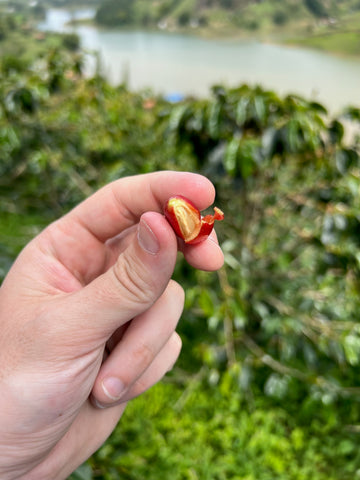

Farm 2 - San Fernando. 10,000kg an hour (!!!); 150 year old house and he’s the grandson of the founder. Absolutely huge farm, which they’re improving and cleaning up area by area. Took a Jeep (‘huilly’) all the way up to the top of the mountain - turns out every area used different 4x4s and it’s a point of pride. Pretty much all caturra variety. Again very healthy plants. Planning on installing solar panels, but again use coal for their drying. Oddly they don’t use any of their parchment, the only answer to this being that they don’t produce enough parchment to entirely power the drier - it all gets sent through central buyers. They had just about every single one of my house plants, and they were all absolutely massive… shouldn’t make me jealous, but here we are.
Lunch / Presentation: went to a beautiful space - roastery, lab, meeting room / restaurant, hotel? No idea? But lovely. Had the usual beans, rice, plantain, but this time with a bean and pig trotter soup. Delicious. Fell apart in your mouth, so good. Was also given a glass of what is apparently milk mixed with corn. Can’t say I had a lot of that… Then had a presentation about El Crecer project. Turns out Racafe is responsible for 11% of Colombian coffee trade, and sells about 45% domestically… something like 1.5 million bags, from seven cities. The idea behind the project is essentially social, economic and agricultural accountability. They’ve checked through about 700 farms so far, and so long as they meet the minimum standards (not burning rainforests etc, they were pretty vague on the standards in particular) then they’re in. They’re then audited against 25 points, each on a score 1-4. The idea is that Racafe then come back six months to a year later and see how they’re doing, see if they’ve taken any of their recommendations, and if they’ve made positive change. The owner of the place we were sitting then gave me a little tour of the lab and roastery - a washed and a honey, all caturra. The washed especially smelled good! He seemed very proud of that.
Buying centre, Bolivar. Same deal as in El Peñol, but on a larger scale unsurprisingly. Guy running the place has been a Q grader for four years. Spikes taken from five different bags (or five points) to get 200g parchment coffee. Milled and then Q graded. Price sorted on 94kg parchment (which gives 70kg yield on average, so 25% loss). Price is all done by this ratio, rather than the puchas of Peñol. Beautiful old moisture meter there, I’d guess to know how long / in what way the coffee needs to be dried.
Time to drive back to Medellin… currently about half an hour in to a three hour journey. Headphones on, listening to Sam Hennshaw. Tarmac has never felt so good. Can’t believe how many garden centres there seem to be (especially yesterday in Guatapé) - don’t know why that surprises me but there you go. Looks like a nice hotel, hoping for a hot shower. Just gone over a bridge where they’re currently only letting one car at a time…interesting. So many landslides that have taken away part of the road on which you’re driving, or have chucked massive boulders on to the side of the road. Just had to stop and wait to get through one part because it’s so covered in mud. Narrow mountain pass on the precipice? Blind corner in 50 yards (that turns out to be a bridge)? Landslide ruined right hand side of the road? Looks like a perfect time to overtake. Apparently every third vehicle is a lorry… on this road at least.
Day 3 - Medellin to Tolima
Racafe mill - apparently one of their smallest, around since the 50s. Still massive! 45% of all coffee produced in Antioquia is from around Bolivar, south west of Medellin. 42% of Racafe sold domestically - majority of this comes from Armenia (lower grades brought from all around). Area south west of antioquia has become very expensive, so now there’s many more smaller farms around Huila and Tolima. Coffee sent through a massive destoner, then milling sorter can process 5000kg per hour, which is then sent through to screen size sorter - sorts by size and density (angled beds with air supply underneath), which is then sent into individual silos by size. Colour sorter - does 1,500kg per hour, constant photos of beans falling through, rejecting any that don’t meet the parameters. If the defect count is too high, it just gets put through again until the defect rate is correct.
Flight to Neiva - Sitting in the airport ready to leave, and Hernan says ‘there are two routes we can take, don’t worry both are safe…..’ makes it sound significantly less safe. In a classic two propellor plane that moves a hilarious amount in the clouds - stunning views of sprawling Medellín though. Have a 6 hour drive ahead of us now, up through the mountains… lots and lots of travelling today. Neiva is in the valley of the Magdalena river - mountain ranges either side which both have lots of coffee. A very hairy drive - constantly guiding through landslides, loads of bits where half of the road has completely disappeared into the river. Could barely see it coming. One of the cars, the one I was in for half the trip, had a faulty brake too which kept making loads of noise!
Dinner - with Camilo of Asopep; apparently this area was incredibly dangerous due to guerilla fighters until 2016! And they mean really, really dangerous. Sitting here now you would have no idea - peaceful, sitting in a lovely open restaurant having a beer! Guerrila movement actually started where we’re going tomorrow - Guytaña (or something similar). The president elect was actually a guerilla in the 80s. Apparently when the guerillas re-entered society from the jungle they had absolutely no idea how to be part of society - no idea how to cross a road!
Day 4 - Planadas
ASOPEP - the second mill (for naturals) and the drying station was funded by the Vatican… €30,000! On this site is the main office, drying facilities (40% received wet), also just a drying station (farmers can pay to have their coffee dried then take it back), and a bio-factory for organic compost. Taking photos of each individual farm by drone to help monitor their health etc - they have 304 farms in total. The idea is to help regeneration - combatting climate change etc to be more sustainable. This compost centre is to create a circular economy, and to maximise the output of the farms. Also to try and combat disease and insects. Cisco de café - parchment. Produces a solid fertiliser called ‘bocaché’ (sp). Also helps to protect the microorganisms in the soil for biodiversity. Then there’s mountain microorganisms in soil (MM). Essentially it’s the topsoil that they then ferment (very strong smell like silage). Kept sealed to stop oxygen so it doesn’t create fungus. They get rid of the top layer of fungus just in case. They also take the cherries from natural processing and do the same - basically just a massive compost pile. Also use trees etc, any biological matter from the farms. Can produce 10,000kg of compost a week! Each producer uses one kilo per tree… really it’s fertiliser, not compost. Aim is to train farmers to make it themselves - bit tricky to get it to very remote farms. Four year old project. Have a 2019 Probattino which was a donation from Madrid…….They pay farmers a premium of up to $20,000 a year for lots that score over 87 - that much if they’re producing 7 tonnes. Asopep spend that money for them on farm improvements.
Composer José Facil Sanchez - instrument called (the weird dragging one, female pig, la marana) typical of Tolima. They have an espresso machine setup donated by the UN. The trainer from 2017 was Diego Campos, the WBC champion 2022! Had a project with European Space Agency to track the differences in land from climate change - apparently the desert to the East is spreading, so it’s reducing the amount of space for growing coffee due to increased temperature and more borer beetles. Fair trade foundation donated $100k for the equipment, and the Colombian govt gave the money for the building of an on-site technical school for coffee production. Due to climate change they started growing cacao in 2015.
Day 5 - Tolima to Neiva
Fascinating cupping. Lots of very interesting processes, none of them over fermented which is nice! Showed us the lab as well, for water and soil - allows them to optimise growth and fermentation (pH measurements, etc). They incinerate the soil and then do chemical analysis on the ashes.
Day 6 - to Popayan
Tribal police on the bridge - apparently there’s no police force in the area! Jesus is the coffee buyer in Inza for Racafe. He’s one of the three main buyers in Inza. Been a trader here for 20 years. Oriado - 20% humidity, versus the completely wet which is ‘Mojado’ at 50%. All sun dried, and they dry it the same day at his own farm. 25000kg dry and 3000kg wet every week (!!) solely on Saturdays. When it’s really busy, more like 70000kg a week. Price on board is for a roja, 12.5kg - think the shipment that came in was worth about $3,500. ‘Especial’ is scoring over 84, ‘en tasa’ (in cup). Jesus goes around all the farms, sends samples to Racafe who score it - they then keep a note of all the farms that score over 84, so they know to pay them more. Ok that’s not quite right, it’s actually done by going around each community (16 of them cover about 400 farms) - they all process the same, so it’s a good way to get an average basically. All parties are paid on cup profile, except the farmer is also paid on ‘the factor’. Interestingly, in Inza the yield is really low due to heavy parchment (high altitude, cold climate). Very good coffee culture in Inza, so farmers know how to process coffee incredibly well - less defects too. This farm is Colombia Supremo (F6), you have to wait for 6 generations to get it! Much bigger beans, same resistance to rust etc. They also have caturra, castillo tembo (a varietal specifically bred for the Cauca region - not much difference between any of the Castillo varietals though, there were seven or so developed originally, around 2000/2001). 23 different genetic lines. Also growing the new varietal cenicafé. 14 month old Caturra growing - always tries to have two trunks per tree. Cenicafe is the ones at the bottom of the farm. Farmer is Freddie Pacue. Wife’s name was Aura, serious hostess! Met Hernan and Elizabeth from CENCOIC this evening too - Elizabeth is in charge of selling I think, while Hernan is all boots on the ground.
Day 7 - Cauca
CRIC - local policing force essentially! There’s no official police, so they work as a community, using information from all of the associations in the area (like Manantial for Laguna). Amount for export this year is likely to be 50%! Bad crop, lockdown (couldn’t get fertiliser etc), and the pressure from cocaine/ laundering issues. 19 reservas that CENCOIC buy from (one new one this year, Toribio) - they had 12 in 2012, and the potential maximum is 80. Each reserva actually has their own dialect too, Spanish speakers can’t understand. They’ve bought an old farm now, which they’re turning into their own mill - means they don’t need to rent space etc. First photos from the road - left is Caldono, right is Laguna! River through the middle is Rio de Ojeras (ear river!). First farm is Caldono - any photos with ‘Shine’ on the shirt and camo trousers. 400 members in Caldono (smallholders), this farm is Jose Manuel. Actual name of this one is San Lorenzo de Caldono. It’s just her and her dad here, and then they employ pickers in the season - the dad is very keen on becoming more organic - crop when organic was crap though, so they now use normal fertiliser (keeping everything else organic), grow Colombia and Castillo. Government allows each farmer to have 50 coca plants per owner (no matter of size of farm). 10 year old trees - chopped to keep short to make it better for pickers, and they chop it every year at the end of the harvest. Traditional catchimbo tree in this area. Also lots of ‘guamo’ trees. Guy in the red CENCOIC hat and jacket is John, one of the technicians - recommends diversity on farms (different plants), using just a machete to reduce erosion (manual labour), also helps with diseases etc. Produces 1250kg, I think (factor of 90 here). Farm is actually called Finca El Mango.
Purchasing station, Caldono. Place is from 2018, but Asprole has been around since 2011. 378 farms deliver here. Asprole de Caldono. Represents 6 sub-reservas. Name of the territory is Nasa Sa’Th Tama Kiwe, in dialect Nassa Yuwe - means ‘the territory of the great chief/leader/mayor’. CENCOIC bought the land, and government provided the money for the building of the station - CENCOIC then take all of the coffee afterwards as they’re partners. Factor is actually around 88-92. They don’t buy wet coffee, but can take up to say 20% and dry it themselves. They buy by weight. They also buy plantains etc, and then give discounts to other members on anything resold, like rice! Members get about a 5-10% discount. They gave us bags!!! They take about 8 days to make, 2-3 hours a day.
Laguna!!! First farm, Angela Patinio. Finca Los Arajanes - a type of tree. It was her father’s farm, and she took it over 20 years ago - it has been part of CENCOIC since 2015. Has 3000 coffee trees, 0.7hct, all Castillo. Her husband also has a farm, but registered as different farmers - they help each other farm. She only has a small farm, so only needs 5 or 6 people at harvest. As it’s all smallholders, they all help each other - pay each other to pick on each other’s farms. Use very little external fertiliser, it’s mainly just from depulping and organic matter. They also have pigs so they use that! Trees around 7 years old, is now stumping by plot. Average she produces 500kg parchment per year, this year maybe 300kg… These are all native trees here, except the plantains - so seriously shade grown, but still with some sunlight - big, big, big cherries, slow growing! Recommend 4000 trees per hectare. Other places recommend 5000 or so. Quite common to integrate coffee farms into the forest, rather than deforesting first and then replanting - part of the culture of the reserva, leaving ancient trees! Space between trees is 170-110. They use moon phases for when they should be doing different aspects of farming - stumping, picking, fertilising etc, as very traditional! Will always harvest coffee before the full moon, for example. Will stump on a full moon, but never on a new moon… Pulp and leave for 18 hours dry fermentation (quite hot here), does four washes. Husband’s name is Juan Camilo Cardona. Anturios - flowers that they grow and sell at market.




Farm 2 of Laguna! Victoria Ines Cardona Yutumbo, member since 2014, farm is Finca Los Très Pinos - third generation farm and Organic since 2019. 0.5 hct and around 2700 trees, all Castillo. Three months fermenting for the holy water, then get a tube to fertilise everything on the farm. Has two silos, and that’s enough for the whole farm. Each is 1000 litres… 20 hour fermentation. Uses the discarded cherries, cow and chicken shit as another type of fertiliser. Dries for 15-25 days depending on climate. This farm only produces 280kg parchment… so 210kg green or so. Going to start picking tomorrow but with 5-6 people so should only take a day. She’s one of 11 children! So this plot of land had no coffee, no house… she planted and built it all, which is incredible. All of the men were given the land with coffee… all 11 children are now growing coffee, and all within Laguna (not all in CENCOIC). Just realised why the colours on Laguna bags are what they are!! It’s the colours of CRIC…




Final day!
Coffee coming in is from Tacueyo. The warehouse - three people in the quality team, and they check every single lot before and after milling. Pablo is one of the three, but he’s currently out at farms to help with processing etc. Henry does the same but he’s here now. They do the training at the farm based on the cupping results - everyone who works in the lab does this. Today we’re mainly cupping individual lots, ones they think are interesting and showing potential. Final one is Lucia, does the same and also logs everything in the system. On the table - Laguna, Munchique, and microlots from Laguna and Caldono. I’m a sucker for Laguna, apparently. Shock horror.


